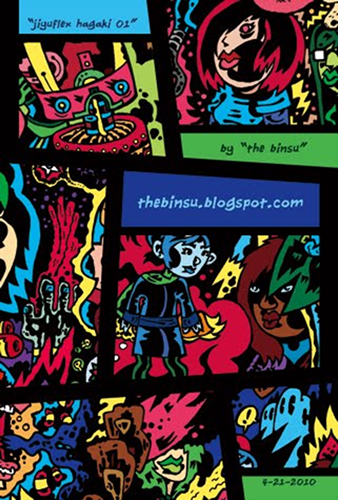2 つの作品からできている「 jiyuflex hagaki 」という絵葉書シリーズの第一目の作品です。「 jiyuflex hagaki 」というシリーズ名は自由帳で絵葉書になるイラストを描いていたことから、そしてたまに使う「 flex 」というペンネームからできました。そして、好きなものを自由に描いたという意味も含まれています。
This is one work from a postcard series called "jiyuflex hagaki," which contains two works total. The reason behind the name "jiyuflex hagaki" is that I originally drew the drawings that were to become picture postcards ("e hagaki" in Japanese) in a type of sketchbook called a "jiyucho" (which literally means "free book," and is considered "free" because it consists of blank pages with no guide lines). Also, my sometimes-pen-name "flex" is part of the series name. And, the fact that I drew what I wanted to draw in a completely "free" (jiyu) manner is also reflected in the title.
スケッチブック代わりに線などが付いていない「自由帳」を非常に使っています。紙の質はスケッチブックよりさらさらしていて、厚くないからトレーシングペーパーのように、下にインク絵などを置くとそのインク絵の線をなぞることもできます(トレーシングペーパーほど薄くありませんので、インクが薄いものや鉛筆で描かれたものは透けて見えませんが)。コピックマーカーのようなグラフィックアーティストのための質の高いマーカーなどもある程度使えますし、フェルトティップペンや筆ペンなども滲みません。欠点としては水彩画や水墨画などに対応しないことと日本製ではない自由帳ならたまにインクペンや筆ペンなどで描いたらかなり滲むこともあるぐらいですね。
I use these "jiyucho," little books of blank paper without lines, instead of sketchbooks a lot. The paper is much smoother than a sketchbook, and because it is not thick, you can trace ink pictures if you place them under the page, like tracing paper (it isn't as thin as tracing paper, though, so you can't see drawings done in light ink or pencil). They take high quality markers for graphic artists like Copic markers fairly well, and don't bleed with felt tip pens or brush pens. Their weak point is that they don't take water color or sumi ink washes, and that you can sometimes experience quite a bit of bleeding with ink pens and brush pens if you use a jiyucho that is not made in Japan.
今回の作品はそんな自由帳にフェルトティップペンや筆ペンなどで描いた何枚かの白黒のインク絵をパソコンにスキャンして、フォトショップというソフトで色を塗りました。色を塗ってからは一枚一枚の作品をパソコン上でバラバラにして、部分的に新しい作品として組み立ててみました。つまり、その過程で出来上がった新しい作品は何枚かのイラストからできた「コラージュ」形式のものです。この「コラージュ」は 2 枚作り上げ、「 jiyuflex hagaki 」シリーズにしたわけです(シリーズにしては作品の数がとても少ないのですが)。
To make the piece I am showing here, I drew several pages of black and white ink drawings in one of these "jiyucho," scanned them into my computer, and colored them with software called Photoshop. After coloring them, I digitally cut them up and created new works out of them. That is to say, the new works I created from this process are collages made up of several different illustrations. I produced two of these collages to make the series "jiyuflex hagaki" (which is kind of a small number of pieces for a series, though).
形は「漫画風」にしました。ストーリはありませんが、あるかのようにコマを一つ一つ追って読んでいくような形で見てもらいたい作品です。アメリカ形式ですので、左から右へ「読む」のです(もちろん、漫画として「読む」のではなく、一枚の絵として「見る」というのも良いです)。
I made them in a "comics style." There is no actual story, but my aim was for the viewer to look at the works in a "reading" style, passing the eye over each individual square. They were done in the American format, so they are to be "read" from left to right (of course, instead of "reading" them as comics, it is perfectly ok to "look" at them as single images.)
今回の作品は以前のものと違って、「意識の流れ」や「 潜在意識 」などの概念に拘らず、色合わせや構成のインパクト感などに重点を置く装飾美術的なアプローチをとることにしました。といっても、コラージュを作るのに使ったイラストはもともと自由に描いたものですので、「 潜在意識 」からのメッセージが取り込まれているかもしれません。
In a departure from previous works, I did not focus on concepts like "stream of consciousness" or "the subconscious mind" with this piece, but instead took a more decorative art type approach that focuses on things like colors working together and the impact of the composition. Of course, even still, the illustrations I used to make the collages were originally drawn in complete freedom, so there may just be some messages seeping up from the subconscious mind here as well. |



